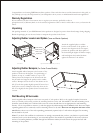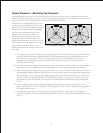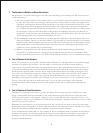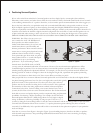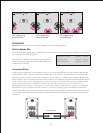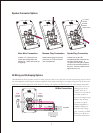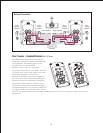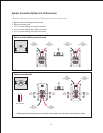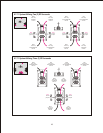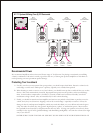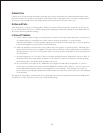
The Speakers in Relation to Room Boundaries
The position of your speakers with respect to the walls, floor, and ceiling of your listening room will often affect their
sound in major ways.
A. The closer you place speakers to the boundary surfaces of your room, the greater the proportion of bass in their
overall sound. This is due to the enclosing, “focusing” effects of nearby surfaces on longer-wavelength (lower)
frequencies. Positioning the speakers near the intersection of two surfaces (wall and wall, wall and floor, or wall
and ceiling) will produce more apparent bass than placement near a single surface. The greatest proportion of
bass is delivered by placement near three intersecting surfaces—in a room corner near the floor or ceiling, where
the convergence of the two walls and the floor/ceiling produces an amplifying effect that is a bit like that of a
megaphone. And the least bass comes from placing a speaker away from all boundaries. Your own tastes should
decide what proportion of bass response seems right in your room.
B. The combination of the three dimensions of your room generally will produce at least three points in the room
where the frequency response you experience related to a given position (of either the speaker or you) will either
greatly increase or almost disappear. The most obvious effects are on low frequencies, but mid-frequency effects,
while usually subtler, are also often present. Keep in mind, then, that very small changes in positioning (of the
speakers or you) may produce major or subtle changes.
C. Distances of speakers from the walls can make great differences in the number, strength, and particular
frequencies of secondary reflections—changing frequency-balance, sonic spaciousness, and definition. Most
listeners prefer their speakers at least a few inches from all walls, but the choice is yours to determine by listening.
You in Relation to the Speakers
Where you sit in relation to your speakers obviously makes a difference too. The proportions of the particular triangle
formed by your speakers and you matter. (You may need to send more power to the more distant speaker to
compensate if you get much further from one speaker than the other.) The overall distances involved also matter. As
you get further from the speakers, more sound reflected from your room’s surfaces (in contrast to the sound coming
directly from the speakers) reaches your ears, and the original spatial relationships in a recording are changed as your
room “takes over.” Sometimes the result is a mellower, more “integrated” sound. Other times, it’s a more strident or
annoyingly “echoey”—or other—quality. Once again, the particular dimensions of your room play a part. And
depending on what seems more realistic and/or enjoyable to your ears, you may choose to sit at a great distance or have
close-up, “near-field” sound. Keep in mind that the right “toe-in,” the right speaker height, and a reasonably
symmetrical distance from the speakers all tend to work together to deliver the best high-frequency definition and
imaging.
You in Relation to Room Boundaries
Changing your own position with respect to a room’s boundaries may also bring a big effect, sometimes for a small
change. Getting further from the wall behind you may make sound more precise and localized. Getting closer may
make sound more “mellow” and integrated. Coming too close—to back wall, side wall, or (especially) a corner— you
may experience a major peak or cancellation of a certain band of frequencies. It depends on factors we can’t cover fully
here but do get into on our web site.
Remember too, with respect to your own positioning, that it may—or may not—be easier to change your own seating
location than to move your speakers. As with so much else in life, the one certain rule is that you shouldn’t fix, or worry
about, what isn’t broken (audibly in this case), especially if it means moving heavy furniture.
As you consider the three relationships we have outlined, the idea is to manipulate whatever variable is easiest and most
productive for improving your listening experience. Be sure to base your judgements on listening to a good variety of
recordings of vocals, and acoustic instruments, soloists, different movies and musical instruments to most easily
recognize tonal balance shifts.
1.
2.
3.
4




